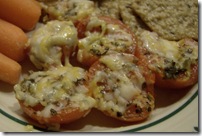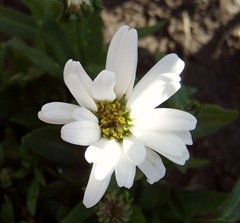Container gardens are not just for apartment dwellers! Even though I live on several acres and have a nice sized garden, I have a container garden. We have a short growing season, coupled with a 30 degree temperature swing every day. This means that spring and fall are pretty inhospitable to plants that like warm temperatures, particularly tomatoes, peppers, and eggplant. So at the end of the season when the nurseries start marking down their veggies, I pick up a few:

They look a little pathetic. Yes, I know, the tomato plant looks really pathetic. The plants were bone dry and shriveled when I bought them (The cashier looked at the plants and said, “well aren’t you a dear soul?” then looked at me like I was Mother Theresa. Or insane; it is hard to tell the two expressions apart). However, they are already showing signs of recovering with nutrient rich soil and water. The tomatoes are ripening and the plants are beginning to flower again:

Once our evening temperatures start to dip into the 30’s, I bring the containers into the garage at night. I put them back out during the day, so they can benefit from the warm afternoon sun and increase their chances of being pollinated.
Things to consider when starting a container garden:
~ Pick the healthiest plants available. There is no reason to follow my example and rescue dying plants.
~
Look for varieties that remain fairly small. These words will often be included in their name: Compact, Space Saver, Patio, Bush. You can grow large varieties if you have large containers, they are harder to lug back and forth.
~ Select a container that will allow for root growth. I use a rule of thumb of picking a container that is at least twice the size of the plant’s root ball.
~ You will need something besides plain old dirt when potting these plants. I
use a mix of 1 part compost to 2 parts commercially prepared potting mix, but any nutrient rich mix will work.
~ Ensure that your
container has holes at the base to permit drainage. You can always create holes yourself by using a hammer and nail to create holes.
~
Container gardens need to be watered daily. If you are going to be away for a day or two, you will want to put the containers in a large tub with an inch of water in it or make arrangements for someone to water for you.
Container gardens are a little extra work, but eating fresh tomatoes and peppers while watching the snow fall makes it worth the effort!
Did I mentioned that I have a short growing season? What hurdles do you face when gardening?
This post has been linked to
Bloomin’ Tuesday and
Tuesday Garden Party.

 When I plant the flowers I just pick up the bucket and tote it around the yard with me. I place the emptied pots back in the bucket, so I only have to make one trip to my recycling/trash bins.
When I plant the flowers I just pick up the bucket and tote it around the yard with me. I place the emptied pots back in the bucket, so I only have to make one trip to my recycling/trash bins.
 Put green beans in a double boiler. Bring water to a boil. Cover with lid and reduce heat. Steam the green beans for 10 - 15 minutes or until they are tender (the time will vary depending on type and thickness of green beans) . They can be a little under done, because they will be cooked some more in the next step. If you don't have a double boiler they can be boiled for 10 minutes instead.
Put green beans in a double boiler. Bring water to a boil. Cover with lid and reduce heat. Steam the green beans for 10 - 15 minutes or until they are tender (the time will vary depending on type and thickness of green beans) . They can be a little under done, because they will be cooked some more in the next step. If you don't have a double boiler they can be boiled for 10 minutes instead. 



























 Now that is the way to show appreciation!
Now that is the way to show appreciation!















